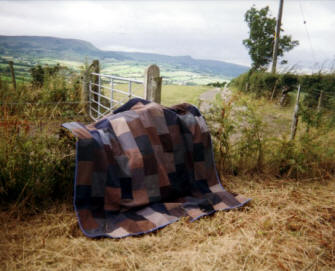
I have been collecting patchwork quilts for twenty-four years. Buying and
acquiring them in all kinds of conditions from various and interesting
sources, encouraging my passion for the study of Irish patchwork, the
needlework and the social history which surrounds them, all of which
fascinate me. These quilts are historical documents, telling a story of a
past life and the families who made them.
 Exhibition at Lisburn Linen Museum,
2001 Signature
blocks - 1895 Dble. Irish chain, 1880 Star, 1930 Exhibition at Lisburn Linen Museum,
2001 Signature
blocks - 1895 Dble. Irish chain, 1880 Star, 1930
I come from a strong needlework background, my grandmothers and great
grandmothers made patchwork quilts. My maternal grandmother Millar worked in
service where the lady of the house taught her many needlework skills, which
she in turn passed on to her daughter, my mother who was the village
dressmaker. She is extremely gifted and talented having also made many
beautiful wedding dresses in her lifetime.
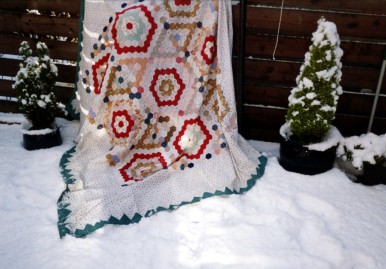 In the 1950’s she kept the famous ragbag of clippings for the women of the
village who gathered the scraps to make their patchwork quilts. Receiving
the scraps gave them the opportunity to express their hidden talent, being
artists in their own right and most importantly, providing a little extra
luxury and colour in their homes when in some cases only a coat or a blanket
would have covered the bed. In the 1950’s she kept the famous ragbag of clippings for the women of the
village who gathered the scraps to make their patchwork quilts. Receiving
the scraps gave them the opportunity to express their hidden talent, being
artists in their own right and most importantly, providing a little extra
luxury and colour in their homes when in some cases only a coat or a blanket
would have covered the bed.
| Coverlett, Hexagon patchwork, c.1895
made to brighten bedroom & look "posh" County (Co.) Tyrone,
North Ireland (N. I.) |

My mother tells me that her grandmother Campbell, my great grandmother, made
red and white patchworks. She also made sacks from ticking, material used to
cover a mattress, which she filled with chaff, worthless husks of corn.
Another example of thrift and nothing wasted. The family slept on these
covered with patchwork quilts.
Irish Chain, c. 1895 Co. Tyrone, N.
I.

| Embroidered Medallion Quilt All hand-made by
Author in 1995 4 Irish Provinces across top, harp & shamrocks in
corners,, Tower & Irish wolfhound in center. Tied with old linen
buttons, green linen & cotton |
When I was a small child, my grandmother Millar thought my time spent
reading Enid Blyton books was wasteful. Grandmother taught me to embroider
and knit. She was born in an era when young girls were encouraged to learn
needlework as a form of security for the future starting with providing for
the girls bottom drawer in preparation for marriage. Being able to create or
make do and mend, having needlework skills was an asset to a young girl if
she wanted to go into service in the big house. An example of her influence,
a hand embroidered patchwork with Celtic patterns; the Irish wolfhound, an
Irish Tower in the centre and the four provinces of Ireland are along the
top.
My keen interest in folk art and social history combined with my needlework
background has been the foundation and inspiration for my collection and the
study of Irish Patchwork Quilts.
Ireland has a long tradition of making patchwork quilts. During the 18th
century patchwork and quilting was introduced to Ireland by the English
gentry. These ladies of high society, living on their Irish country estates,
were known to
have taught many needlework skills, including patchwork and
quilting to those working in service, in time this craft spread to surrounding cottages, villages and towns. Ireland’s tradition of patchwork
and quilting thrived and grew rapidly out of thrift and necessity.
Traditionally, Irish patchwork comprise of two layers the top and the
backing stitched together with wave or chevron patterns. The early patchwork
introduced in Ireland were similar, it seems the Irish carried on this
tradition, handing it down from generation to generation. The Irish lived in
small communities on an island with little opportunity for travel. These
factors helped to keep the tradition as it was. It is also thought they
could not afford to line a quilt the wool would have been needed for another
use.
surrounding cottages, villages and towns. Ireland’s tradition of patchwork
and quilting thrived and grew rapidly out of thrift and necessity.
Traditionally, Irish patchwork comprise of two layers the top and the
backing stitched together with wave or chevron patterns. The early patchwork
introduced in Ireland were similar, it seems the Irish carried on this
tradition, handing it down from generation to generation. The Irish lived in
small communities on an island with little opportunity for travel. These
factors helped to keep the tradition as it was. It is also thought they
could not afford to line a quilt the wool would have been needed for another
use.
| "Thrift patchwork" in wool, crazy style, c.
1900 Patched in 1950s with the blue checked cotton Belfast, N.I. |
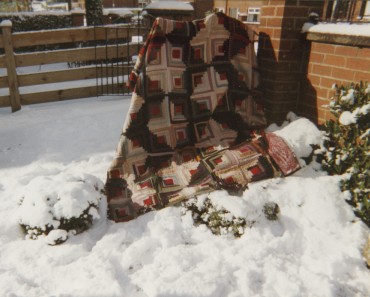
| Log Cabin, wool & flannel, c. 1885 Island
Magee, Co. Antrim, N. I. |
In mountainous, bleak and rural areas of Ireland, an old worn blanket or
sheet could have been added to a patchwork giving it extra weight and
warmth, looking very rough and primitive these patchworks were purely
functional made from hand woven fabrics, tweeds and old suiting, they were
usually tie quilted with carded sheep’s wool or roughly quilted with linen
thread
The types of patchwork quilts made in Ireland were log cabin, crazy, Irish
chain, signature, mosaic, frame, block, and many examples of appliqué.
Turkey red and white patchwork quilts were very common in Ulster, and were
often referred to as an Ulster patchwork quilt. It looked bright and
cheerful in the dark cottages with the flickering lights of the turf fires.
Quite often these patchworks were hand pieced, then machine quilted, it
seems the finished quilt with it’s patterns and colour were more important
than the hand quilting which would have been time consuming when many other
household tasks needed to be done. As not many owned a sewing machine it was
prestigious to show of machine quilting, giving the impression that she was
better of than she really was.
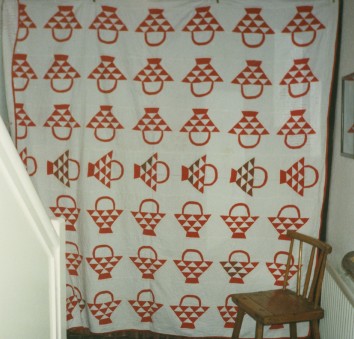
| Baskets, c. 1900, wedding gift as baskets
denote plenty for prosperity Hand quilted in Waves pattern, C. Down,
N.I. |
In the case of families who were too poor to cut up their clothes for
patchwork, they would get pieces from sources such as dressmakers,
travellers, shop samples, factories and linen mills. Some linen merchants
had a day in the week, when they sold pieces of linen to their workers, for
the purpose of making patchwork quilts. These linen pieces were often made
into frame patchworks quilts that were very fashionable in Northern Ireland.
There are many examples of black material appearing in Ulster frame quilts.
The black material was originally used for mourning, but also during the
second world war black material was used to put over windows to prevent the
light getting out during the blitz, hence the name black out material, when
it was no longer needed it was put to a good use.

From the late 1800s, Belfast and Londonderry had many shirt making
factories, these shirts going all over the world as far away as Australia.
As orders increased, the factories developed a system for out workers around
the countryside. Due to this industry, many shirt scraps were available
which were purchased at the factory shops in bags according to weight. The
workers made the patchworks in their spare time and then sold them.
| Frame patchwork, c.1940 blackout material &
furnishing prints Belfast, N.I. |
Stories are told about men picking up the patchwork quilts on their bicycles
and selling them for the out workers around the doors, they were very
popular and often referred to as The Derry Quilts, The Shirt Quilts, and The
Belfast Patchwork. In Northern Ireland, it appears patchwork quilts were
labelled according to their source and material rather than the patterns.
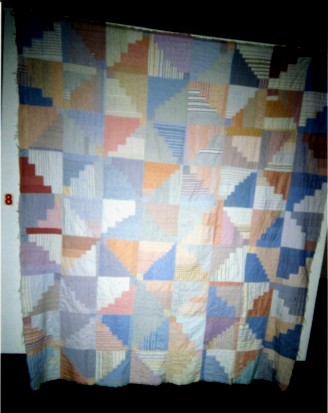
These utility patchwork quilts along with scraps from linen handkerchiefs
table cloths and pyjama factories, provide a great insight into the Northern
Ireland textile Industry reminding us of a by gone era. Flour bags were
saved, washed and bleached to use as a back to the patchwork. During the
Second World War the American army was stationed in Northern Ireland, they
had their own bakery in Crumlin, Co. Antrim. The flour was shipped from
America. The bags from this flour are often found on the back of Co. Antrim
patchworks made in this time.
|
Shirtings in log cabin, c. 1890,
Co. Derry, N. I. |
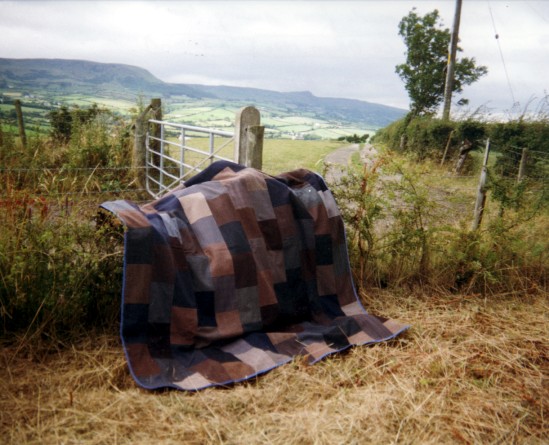
|
Wool suiting samples patchwork,
c.1920,
Banbridge, Co. Down, N. I., on the hills above the Antrim Coast on
the Irish Sea |
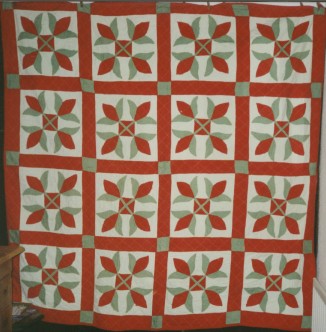
Many of the patterns found in Irish patchwork are very similar to American
patterns. Nostalgic emigrants whose thoughts lay in the green fields of
Ireland stitched their Irish patterns in the new world. They also sent ideas
back to their homeland.
| Photo left: Tulips,
machine appliqué and quilted, no filler, Common pattern in Ire. ,
ancestors immigrated to PA and sent pattern home; called American quilt
Ballymoney, Co. Antrim, N.I., late 1800s |
In the 18th century, many waves of Scots Irish Presbyterians emigrated from
Ulster to America. They sailed out of the ports of Belfast, Londonderry, Portrush, Newry and Larne travelling in simple wooden ships bound for many
destinations in America. Pennsylvania was their favourite colony. They left
an indelible mark in the society of Eastern and Western Pennsylvania. In
time they experienced the cross culture of European folk art often seen on
painted furniture. The European folk symbols of hearts, birds and tulips are
very often found on early Ulster appliquéd quilts. On occasions, I have
spoken to different families in Co. Antrim especially in the town of
Ballymena, where there is a very strong descent from the Ulster Scots. They
often talk about their family connections in Pennsylvania who sent quilt
patterns to their grandparents. Londonderry, Portrush, Newry and Larne travelling in simple wooden ships bound for many
destinations in America. Pennsylvania was their favourite colony. They left
an indelible mark in the society of Eastern and Western Pennsylvania. In
time they experienced the cross culture of European folk art often seen on
painted furniture. The European folk symbols of hearts, birds and tulips are
very often found on early Ulster appliquéd quilts. On occasions, I have
spoken to different families in Co. Antrim especially in the town of
Ballymena, where there is a very strong descent from the Ulster Scots. They
often talk about their family connections in Pennsylvania who sent quilt
patterns to their grandparents.
Snowflake or Joined Hearts quilt, hand pieced
& app., machine quilted, typical pattern in Ulster, co. late 1800s
When the pattern was followed and the quilt made in Ireland it was always
referred to with great pride as “The American Quilt” even though their
grandmother made the quilt in Ireland, . When people left Ireland and made
good in America they sent money to their families back home. There was a
well-known saying in Ireland if someone did a job that was easy, they would
say it was money from America. Because of
this strong connection, America was very important to the Irish especially
to families with Irish/American quilts. They were treasured because of the connection so far away. The quilts were kept as the “Good Quilt” to be used
only on special occasions. from America. Because of
this strong connection, America was very important to the Irish especially
to families with Irish/American quilts. They were treasured because of the connection so far away. The quilts were kept as the “Good Quilt” to be used
only on special occasions.
|
Floral applique, c. 1890, Cullybacky, Co. Antrim, N. I.
|
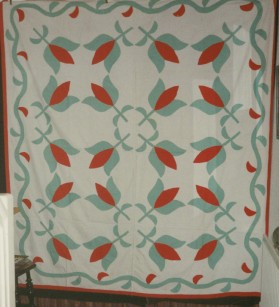 The period of the potato famine (1845-1849) was a turning point in Irish
history when mass emigration took place taking their traditions with them.
This exodus made it very difficult to leave families behind, in most cases
forever. The last night at home was often referred to as the American Wake.
Many emigrants carried their belongings tied in a patchwork, using it on the
long journey, while others made patchworks on route. Some letters reveal
that when they arrived on the beaches their quilts were washed and laid on
the rocks to dry. Other letters tell that patchwork quilts were sent from
Londonderry to America for wedding presents and others to the young
immigrants who had just settled in the new world. The period of the potato famine (1845-1849) was a turning point in Irish
history when mass emigration took place taking their traditions with them.
This exodus made it very difficult to leave families behind, in most cases
forever. The last night at home was often referred to as the American Wake.
Many emigrants carried their belongings tied in a patchwork, using it on the
long journey, while others made patchworks on route. Some letters reveal
that when they arrived on the beaches their quilts were washed and laid on
the rocks to dry. Other letters tell that patchwork quilts were sent from
Londonderry to America for wedding presents and others to the young
immigrants who had just settled in the new world.
| Large Tulips
coverlett, c. 1900, hand applique, no quilting, edged in Turkey Red,
Scotish/irish maker Ballymena, Co. Antrim, N.I.
|
The older generation in Ireland think it very strange to show interest in
old patchwork quilts because they were made during hard times, it reminded
them of doom and gloom. When people became better of and could afford to buy
other bedding including the candlewick, they often burnt the old patchworks
to forget about the hard times. When they look back, they think of it as
being shameful to have had to cut up their cloths for patchwork quilts.
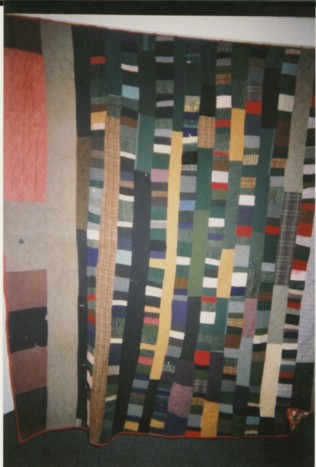
I like to try and identify where the fabrics have come from. I have on
occasions come across tattered, dirty and worn quilts, which most people
would look upon with distain. I like them in any condition because I have
always seen beyond that. They are examples in their own right. I think of
the person who made the patchwork quilt, the limited availability of fabric,
the pattern used, be it naĂŻve or artistic, the hidden talent, what motivated
the maker to put it together, the admiration of how something was produced
from very little or what was recycled and of course the pleasure in admiring
a another persons work from days gone by.
Rectangles on the
Run, c. 1900, made from many different fibers, "thrift patchwork",
co. Down
Roselind is a quilt maker and
historian, living in Belfast, N.I. with her husband. They have three grown
sons, living in the UK. We met when she took my quilt history tour. We share
similar interests and intrigue in the history of sewing techniques and
quilts in the US and the UK. Thank you Roselind for sharing your knowledge and photos
of your collection of Irish quilts. She can be reached a
wjamesshaw@hotmail.com.
See also:
The Irish Chain Quilt ~ Irish or Not?
|